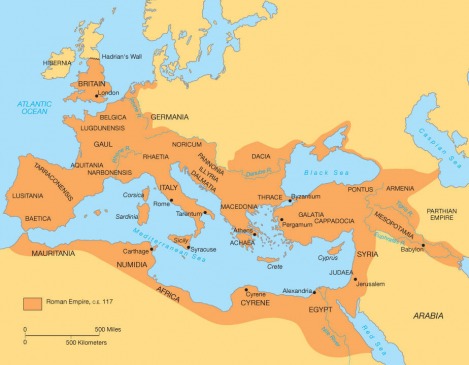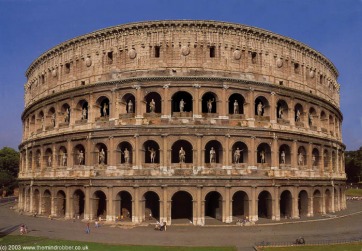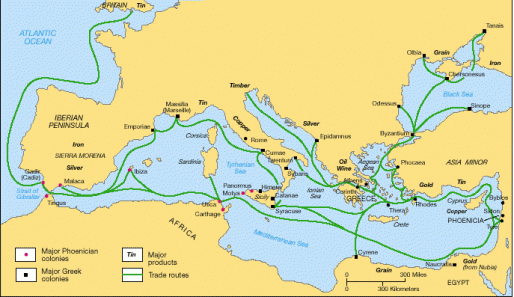
Welcome to Rome- the land of Augustus and perhaps the most interesting empire of their time.
Rome started off as a small village, but by 700 BC, it had grown to a massive city. The population increased, technology became more advanced, and the government became stronger and more complex.
Vocabulary
emperor - leader who had the power to
-- declare war
-- raise taxes
-- punish lawbreakers
-- nominate public officials
-- influence meetings of the senate
-- lead religious festivals
citizens - the people who could participate in government
aqueducts - human-made channels that carried water from distant mountain ranges into Rome
innovation - a new idea or way of doing something
efficient - productive and not wasteful
corruption - the decay of people's values
mosaics - pictures made with pieces of colored stone or glass
Important People
Stoics - Group of Roman philosophers who taught to focus on living a virtuous life
Augustus (63 BC-AD 14) - Rome's first emperor, originally named Octavian. He defeated Marc Anotony and therefore won control of Rome.
Diocletian (c.245-316) - Emperor who divided empire into two halves and ruled the east
Constantine (c.280-337) - First Christian emperor who briefly united the two halves of Rome and declared Constantinople the capital.
Clovis (c.466-511) - Frankish king who built a huge kingdom in Gaul
Attila (c.406-453) - Leader of the Huns who led invasions of Constantinople, Greece, and northern Italy
Justinian (c.483-565) - Emperor of eastern Roman Empire, organized all laws into a legal system called the Justinian Code. He built the Hagia Sophia and reconquered much of the Mediterranean.
Theodora (c.500-548) - Empress of Roman empire and Justinian's wife, helped him rule.
Geography

By 117, The Roman Empire had expanded toSpain, Gaul, Britain, Italy, Greece, Asia Minor, Syria, Egypt, and other parts of northern Africa. At the height of the Roman Empire, it controlled all lands around the Mediterranean Sea. (See map)
The Danube and Rhine River were soon included in the Roman Empire, but even big rivers like the Euphrates, Tigris, and Nile Rivers were eventually under control of the Romans.
Most of the countryside was green and hilly, while the cities were bustling with people and shops.
Religion
Rome was basically made up of all Christians by the 300s. This was mainly due to the new emperor becoming Christian. With more and more people following suit, the influence of the church became a large part of society, along with its leaders. All together, the emperor, pope, and bishop made Rome a Christian society.
Later, during the time when Rome was divided in half, Christianity became interpreted and practiced differently throughout the empires. The west remained Christian, and the East formed the Eastern Orthodox Church.
Achievements
Government - Importance of written laws on display, Equal treatment for all citizens, Duties of citizens
(Influenced U.S. Constitution)
Engineering - Durable roads, Strong bridges, Aqueducts, Building designs that inspired later societies
(Roads today still use original ideas from Romans)
Architecture - Large and strong buildings, Columns and open spaces
(Inspired California State Capitol and other main buildings)
Art - Realistic statues, Lifelike portraits
(Artists still study paintings to learn about their style and realism technique)
Philosophy - Focused on improving people's lives, Emphasized people's civic duty
(Countries today still use the theory that people should fight for the good of their land, not for personal gain)
Buildings

Colosseum - (Left)
One of the most amazing display of Roman architecture, the Colosseum stands 160 feet high and has a base covering roughly 6 acres. After 10 years of building, the Romans really had something to be proud of. Being able to hold 50,000 spectators, this amphitheatre was the prime spot for entertainment. People came from all over Rome to watch gladiator fights, chariot races, and elaborate reenactments of major battles or achievements. Don't be packing to go on a day trip, though. Many games were “sudden death”, to say the least, with people fighting to the death. Gladiators, criminals, prisoners, and slaves fought animals or each other on a daily basis. Believe it or not, Romans enjoyed watching gory battles to the death. The more blood and screaming, the better, apparently.
Others -
-- Arch of Constantine
-- Arch of Titus
-- Arch of Severus
-- Hagia Sophia
-- And many, many more....
***BONUS - You can take a virtual tour! Explore the Colosseum and Arch of Constantine for yourself! Enjoy the bright sunshine of Italy right from your own living room! Click here.
Animals
Sadly, most of the animals in Ancient Rome were used in the Colosseum for entertainment. Large animals, like lions and tigers (nope, no bears in this category), were used to fight each other or humans. Horses were used in races; giraffes, elephants, and occasionally bears were used in parades; boars, fish, and fowl were used for publicized hunting. There were rarely any personal pets, though if there were, it was dogs, cats, or insects.
Trade

Rome had many trade routes and tried to make trading as easy as possible for everyone. They built lighthouses and docks for sea travel, and roads for land. They imported beef, corn, glassware, iron, lead, leather, silk, silver, and spices. They traded with the common currency and with wine, olive oil, and pottery. (See trade routes at left)
Government and Social Structure

Romans decided that more than one man should make the decisions. They therefore developed three branches of government - executive, legislative, and judicial. Below these and the emperor lay many more groups that helped Rome run smoothly. They used a system of checks and balances, which made sure that no one branch had too much power.
Executive - Two leaders were consuls - elected for one year. Supervised Senate and ordered army. Other members were tax collectors, mayors, or city police.
Legislative - Senate - group of 300 male citizens who owned land; appointed by consuls.
Judicial - Had six judges who were elected every two years - in charge of punishing criminals (Similar to judges today in the United States)
Tribunes - People who spoke for the poor people of Rome - had power to veto Senate's laws.
Assembly - Roman citizens who voted and elected the senators and consuls.
Patrician - Those born into high social ranking
Plebeians - Working class
Slaves - Treated with disrespect like all the other slaves throughout the world
One of the most well known form of Roman law is the Twelve Tables. It is the code for the Romans was carved onto pieces of stone. Having laws written down kept officials changing them to fit their needs. They could also be broadcasted throughout Rome.
Invasions
Effective as Rome was, there were still many invaders. Barbarians from Germany, the Huns, Goths, Vandals, Angles, Saxons, Jutes, and Franks all wanted part of the empire. In the end, the eastern empire lasted for many more years than the west, but they both met their ends against invaders. In the west, it was the Huns and other barbarians; in the east (Byzantine Empire), it was the Ottoman Turks.
